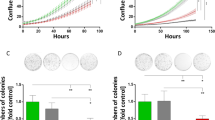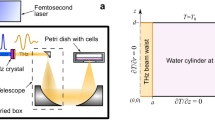Abstract
Exposure limits set for microwave radiation assume that any biological effects result from tissue heating1: non-thermal effects have been reported but remain controversial. We show here that prolonged exposure to low-intensity microwave fields can induce heat-shock responses in the soil nematode Caenorhabditis elegans. This effect appears to be non-thermal, suggesting that current exposure limits set for microwave equipment may need to be reconsidered.
This is a preview of subscription content, access via your institution
Access options
Subscribe to this journal
Receive 51 print issues and online access
$199.00 per year
only $3.90 per issue
Buy this article
- Purchase on Springer Link
- Instant access to full article PDF
Prices may be subject to local taxes which are calculated during checkout


Similar content being viewed by others
References
ANSI/IEEE C95.1-1992 American National Standard-Safety Levels with Respect to Exposure to Radio Frequency Electromagnetic Fields, 3 kHz to 300 GHz (IEEE, New York, 1992).
Parsell, D. & Lindquist, S. Annu. Rev. Genet. 27, 437–496 (1993).
Dennis, J., Mutawakil, M., Lowe, K. & de Pomerai, D. Aquatic Toxicol. 40, 37–50 ( 1997).
Candido, E. & Jones, D. Trends Biotechnol. 40, 125–129 (1996).
Daniells, C. et al. Mutat. Res. 399, 55– 64 (1998).
Snutch, T. & Baillie, D. Can. J. Biochem. Cell Biol. 61, 480–487 (1983).
Gandhi, O., Lazzi, G. & Furse, C. IEEE Trans. Microwave Theor. Tech. 44, 1884–1897 (1996).
Nishizawa, J. et al. Circulation 99, 934– 941 (1999).
Williams, P. & Dusenbery, D. Environ. Toxicol. Chem. 9, 1285–1290 (1990).
Jewitt, N., Anthony, P., Lowe, K. & de Pomerai, D. Enzyme Microb. Technol. 25, 349–356 ( 1999).
Author information
Authors and Affiliations
Rights and permissions
About this article
Cite this article
de Pomerai, D., Daniells, C., David, H. et al. Non-thermal heat-shock response to microwaves . Nature 405, 417–418 (2000). https://doi.org/10.1038/35013144
Issue Date:
DOI: https://doi.org/10.1038/35013144
This article is cited by
-
Pulsed 3.5 GHz high power microwaves irradiation on physiological solution and their biological evaluation on human cell lines
Scientific Reports (2021)
-
Effects of radiofrequency field exposure on proteotoxic-induced and heat-induced HSF1 response in live cells using the bioluminescence resonance energy transfer technique
Cell Stress and Chaperones (2021)
-
The assessment of electromagnetic fields-caused genetic diversity of Tea Camellia sinensis L. using ISSR and SCoT markers
Brazilian Journal of Botany (2020)
-
Comparison of biological effects of modulated electro-hyperthermia and conventional heat treatment in human lymphoma U937 cells
Cell Death Discovery (2016)
-
Effects of electromagnetic fields exposure on plasma hormonal and inflammatory pathway biomarkers in male workers of a power plant
International Archives of Occupational and Environmental Health (2016)
Comments
By submitting a comment you agree to abide by our Terms and Community Guidelines. If you find something abusive or that does not comply with our terms or guidelines please flag it as inappropriate.



